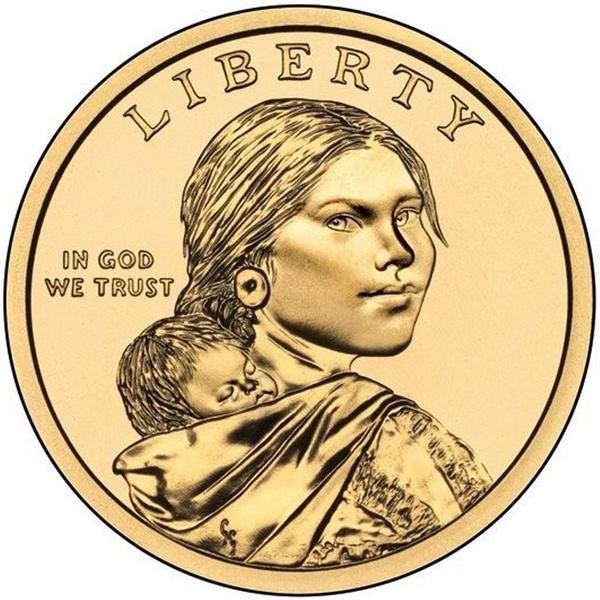Sacagawea Golden Dollar Coin
Obverse
© 2022 by WikiCommons user Tommy5544. Permission to use granted under the Creative Commons Attribution-Share Alike 4.0 International license.
This design by Glenna Goodacre and modeled by Shoshone Randy’L He-dow Teton has fronted the Sacagawea Golden Dollar and Native American $1 coins since 2000. By featuring Sacagawea in three-quarter profile, Jean Baptiste Charbonneau can be seen in a sling on her back. Following Shoshone legend, she has been given large, dark eyes.[1]“Sacagawea Golden Dollar Coin,” United States Mint, accessed 22 May 2023, www.usmint.gov/coins/coin-medal-programs/circulating-coins/sacagawea-golden-dollar.
Jean Baptiste Charbonneau was the son of the Lewis and Clark Expedition’s most popular member, Sacagawea, and the too often maligned French Canadian Toussaint Charbonneau. His storied life can be roughly divided into periods. His first 24 years were his education when he traveled with the Lewis and Clark Expedition, lived in a Hidatsa village, and was schooled in St. Louis and Württemberg, Germany. The second period (seventeen years) was in the Rocky Mountains as trapper, guide, and hunter. He lived his last twenty years in California where he served as an alcalde, miner, and hotel clerk in the California gold fields.
Because we have no journal or memoir, what can be learned of Jean Baptiste Charbonneau must come from the writings of others. Fortunately, he appears in many primary sources from the first half of the 19th century—a period of rapid western expansion in the United States. Unfortunately, some early historians have sometimes misinterpreted those primary sources, and their mistakes have often been quoted as fact by subsequent biographers. From the primary sources, the following timeline emerges.
Timeline
- 11 Feb 1805: Birth at Fort Mandan
- May-June 1806: Long Camp illness
- July 1806: At Pompeys Pillar
- 1809: St. Louis Baptism
- 1812: Probable death of mother
- 1813: William Clark becomes guardian
- 1823: Meets Duke Paul
- 1829: Return from Europe
- 1830: Robidoux Fur Brigade
- 1832: With Jim Bridger
- 1834: With Tom Fitzpatrick
- 1839: On the South Platte
- 1842: “Helena” Island host
- 1843: Muleskinner for William Drummond Steward
- 1843: Settles father’s affairs in St. Louis
- 1844: Bent’s Fort hunter
- 1845: Meets James Abert
- 1846–47: Mormon Battalion guide
- 1847: Alcalde at Mission San Luis Rey
- 1849: Likely arrival at Buckner’s Bar
- 1852: Placer County assistant surveyor
- 1860: Miner living at Secret Ravine
- 1861: Clerk at Orleans Hotel
- 1866: Dies traveling to Montana
The Life of Jean Baptiste Charbonneau
Jean Baptiste in the Journals
Baby on board
by Kristopher K. Townsend
The captains’ journals give us a small glimpse into the experiences of Jean Baptiste Charbonneau as he traveled with the Lewis and Clark Expedition.
A Flash Flood
A narrow escape
by Joseph A. Mussulman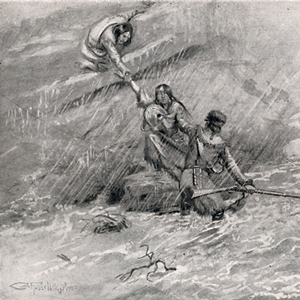
Of all the near-calamities the Corps of Discovery experienced, none was more dire than the one that occurred on 29 June 1805 in a normally dry ravine a short distance above the Great Fall. The principals were Charbonneau, Sacagawea, Jean Baptiste, York, and William Clark.
Pompeys Pillar
Pompy's Tower
by Joseph A. Mussulman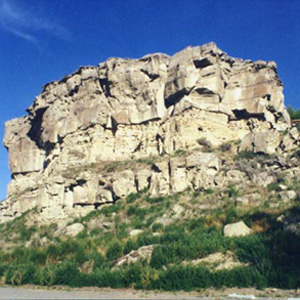
On 25 July 1806, Clark and his contingent of nine men, plus York, Toussaint Charbonneau, Sacagawea, and little Jean Baptiste, arrived at “a remarkable rock Situated in an extensive bottom, on the Star[boar]d. [south] Side of the river.”
An Offer to Raise Jean Baptiste
Clark's promises
by Joseph A. Mussulman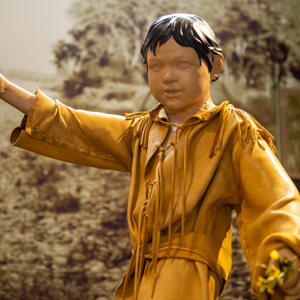
Clark’s affection for Sacagawea’s little boy, Jean Baptiste, becomes evident while canoeing down the Yellowstone River. This article analyzes Clark’s offer to his father, Toussaint Charbonneau, to raise the child.
The Charbonneaus in St. Louis
by Robert J. Moore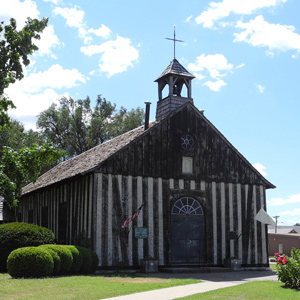
In 1809, Toussaint, Sacagawea, and Jean Baptiste Charbonneau traveled to St. Louis. Jean Baptiste’s baptism began a new era in his life, is father would try to become a farmer, and Sacagawea would become sickly.
Educating Jean Baptiste
Knife River and St. Louis
by Kristopher K. Townsend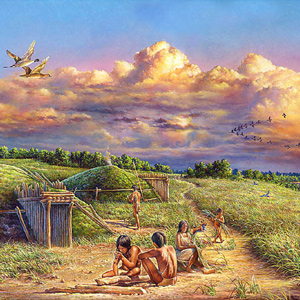
Jean Baptiste Charbonneau’s education began in a Hidatsa village. In St. Louis at the age of five or six, his classical education began under the guardianship of William Clark.
Jean Baptiste in Europe
by Kristopher K. Townsend
Jean Baptiste’s European experiences with Duke Paul of Württemberg were the capstone of an education that started in a Hidatsa village and developed in St. Louis under the sponsorship of William Clark.
Jean Baptiste, Mountain Man
by Kristopher K. Townsend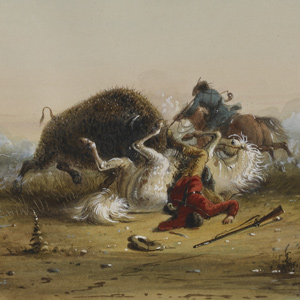
Jean Baptiste’s 17-year career as a mountain man comes from a scattering of writings from some of the most notable trappers of the era.
Jean Baptiste, Military Guide
With the Mormon Battalion
by Kristopher K. Townsend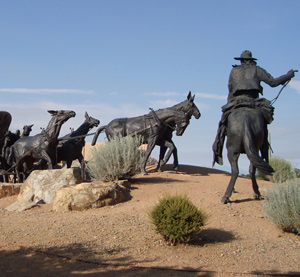
As a military guide in the U.S.-Mexican War, Jean Baptiste and the Mormon Battalion were involved in a defining moment in the American Southwest.
Jean Baptiste in California
by Kristopher K. Townsend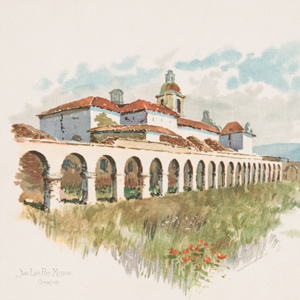
After a brief service as Alcalde of San Luis Rey, Jean Baptiste moved to the gold fields around Auburn, California where he lived for 19 years.
Jean Baptiste’s Final Journey
The trail's end
by Kristopher K. Townsend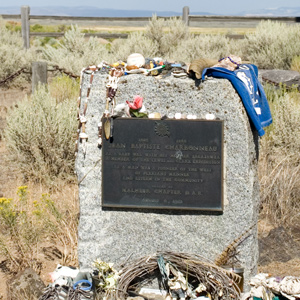
Perhaps he was seeking new gold fields, maybe California was getting too crowded, or maybe he simply wanted to see the mountains and prairies of his mountain man days. After a long life, the journey would be his last.
Notes
| ↑1 | “Sacagawea Golden Dollar Coin,” United States Mint, accessed 22 May 2023, www.usmint.gov/coins/coin-medal-programs/circulating-coins/sacagawea-golden-dollar. |
|---|
Experience the Lewis and Clark Trail
The Lewis and Clark Trail Experience—our sister site at lewisandclark.travel—connects the world to people and places on the Lewis and Clark Trail.
Discover More
- The Lewis and Clark Expedition: Day by Day by Gary E. Moulton (University of Nebraska Press, 2018). The story in prose, 14 May 1804–23 September 1806.
- The Lewis and Clark Journals: An American Epic of Discovery (abridged) by Gary E. Moulton (University of Nebraska Press, 2003). Selected journal excerpts, 14 May 1804–23 September 1806.
- The Lewis and Clark Journals. by Gary E. Moulton (University of Nebraska Press, 1983–2001). The complete story in 13 volumes.
